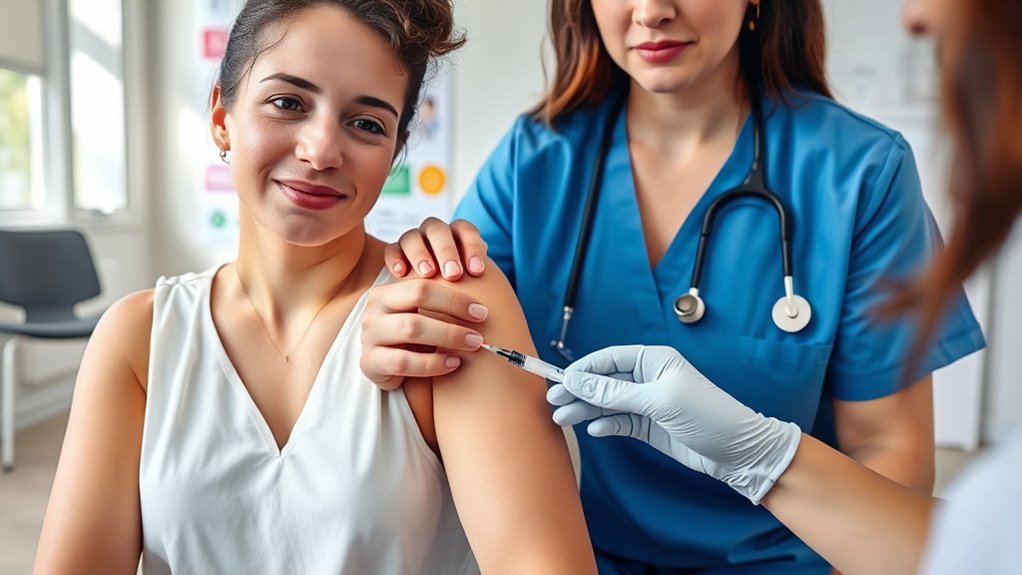To prevent cervical cancer, get the HPV vaccine, ideally before becoming sexually active, as it protects against high-risk HPV strains. Regular screening with Pap smears and HPV tests can detect abnormal cells early, allowing for simple treatments before cancer develops. Combining vaccination with routine screenings greatly reduces your risk. Staying informed about these strategies helps safeguard your health—keep exploring to learn more about how you can stay protected.
Key Takeaways
- Regular Pap smears starting at age 21 enable early detection of abnormal cervical cells.
- HPV vaccination before sexual activity offers strong protection against high-risk HPV strains.
- Combining vaccination with routine screening significantly reduces cervical cancer risk.
- Screening intervals vary, typically every 3-5 years, depending on age and test results.
- Consistent adherence to prevention guidelines and early treatment prevent progression to cervical cancer.

Cervical cancer prevention is essential for reducing the risk of developing this potentially deadly disease. One of the most effective ways to do this is by understanding HPV transmission and following screening guidelines. Human papillomavirus (HPV) is the primary cause of cervical cancer, and it spreads easily through sexual contact. That’s why practicing safe sex, such as using condoms and limiting the number of sexual partners, can considerably reduce your risk of HPV transmission. Even with these precautions, HPV can still be transmitted, which makes regular screening crucial.
Screening guidelines are designed to catch precancerous changes early, before they develop into cancer. Most women should start getting Pap smears at age 21, regardless of sexual activity, and continue at regular intervals. The Pap test detects abnormal cells on your cervix that could develop into cancer if left untreated. Depending on your age and previous results, your healthcare provider might recommend co-testing with an HPV test, which looks specifically for high-risk HPV types linked to cervical cancer. This combination increases the accuracy of screening and helps identify women at higher risk.
Adhering to screening guidelines is key because early detection allows for simple treatments that can prevent cancer altogether. For example, if abnormal cells are found during a screening, your doctor can remove or treat them before they turn into malignant tumors. It’s important to remember that screening isn’t a one-time event; it’s an ongoing process. The frequency of tests depends on your age and health history, but most women are advised to have a Pap smear every three years or to combine it with an HPV test every five years if your results have been normal. Staying consistent with these screenings can drastically lower your chances of developing advanced cervical cancer.
In addition to regular screenings, vaccination plays a crucial role in prevention. The HPV vaccine protects against the most common high-risk strains that cause cervical cancer. It’s recommended for preteens and young adults, ideally before they become sexually active, but even those who are already sexually active can benefit from vaccination. Combining vaccination with adherence to screening guidelines creates a strong defense against HPV transmission and cervical cancer. Furthermore, choosing high-quality projectors for home cinemas can enhance the viewing experience of educational content on health topics, making learning about prevention more engaging.
Frequently Asked Questions
Can Men Receive the HPV Vaccine for Cervical Cancer Prevention?
Yes, men can receive the HPV vaccine for gender-specific prevention. While it’s primarily recommended for females to prevent cervical cancer, vaccinating males helps protect them from HPV-related cancers and genital warts. By getting vaccinated, you not only reduce your own risk but also contribute to community-wide protection. Men’s vaccination is an important part of all-encompassing HPV prevention strategies, helping to lower HPV transmission and associated health issues for everyone.
Are There Any Side Effects Associated With the HPV Vaccine?
Imagine a gentle breeze versus a storm—that’s how vaccine side effects can feel. The HPV vaccine is safe for most, with minor side effects like soreness, redness, or a slight fever. Vaccine safety is well-studied, and serious reactions are rare. If you experience discomfort, side effect management involves rest and over-the-counter pain relievers. Overall, the benefits of protection against HPV far outweigh the minor, temporary side effects.
How Effective Is the HPV Vaccine in Preventing Cervical Cancer?
The HPV vaccine is highly effective in preventing cervical cancer, with vaccine efficacy reaching about 90% when administered before HPV exposure. It works by blocking the most common cancer-causing HPV types, markedly reducing your risk of developing cervical cancer later in life. By getting vaccinated, you actively participate in cancer prevention, protecting yourself and reducing the overall burden of HPV-related cancers.
Is the HPV Vaccine Recommended for Older Women?
If you’re an older woman considering the HPV vaccine, it’s generally not recommended after age 26, but there are exceptions. For example, a 35-year-old woman with new sexual partners might benefit, as age considerations and vaccine efficacy vary. While the vaccine is most effective when given early, it can still provide some protection against new HPV infections later in life. Consult your healthcare provider to assess your specific risk.
How Often Should Women Get Screened After Vaccination?
You should follow recommended screening intervals based on your vaccination timing and age. Generally, women aged 21-29 should get a Pap test every three years, regardless of vaccination status. For women 30-65, you can opt for a Pap test combined with HPV testing every five years or a Pap test alone every three years. Vaccination doesn’t eliminate the need for regular screening, so stick to your healthcare provider’s advice.
Conclusion
By staying up-to-date with HPV vaccinations and regular screenings, you greatly lower your risk of cervical cancer. Some might think it’s unnecessary if they’re healthy, but catching issues early truly makes a difference. Don’t wait until symptoms appear—preventive action saves lives. Taking these simple steps empowers you to protect your health now and in the future, ensuring you stay cancer-free and confident in your well-being.









